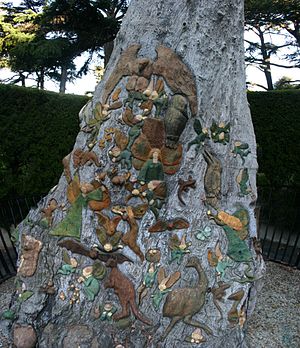- Ola Cohn
-
Ola Cohn Birth name Carola Cohn Born 25 April 1892
Bendigo, Victoria, AustraliaDied 23 December 1964
Cowes, VictoriaNationality Australian Field Sculpture, Training Swinburne Technical College, Royal College of Art in London under Ernest Cole and Henry Moore Movement Modernist Works Fairies' Tree, Head of a Virgin, Abraham, statue in Adelaide Pioneer Women's Garden Awards Crouch Prize (1952), MBE Ola Cohn, born Carola Cohn in Bendigo (25 April 1892 – 23 December 1964) was an Australian artist, author and philanphropist best known for her work in sculpture in a modernist style and famous for her Fairies Tree in the Fitzroy Gardens, Melbourne.[1][2][3]
Ola was educated at Girton College, Bendigo, then studied drawing and sculpture at the Bendigo School of Mines. She continued her studies in Melbourne at Swinburne Technical College and then at the Royal College of Art in London.[2] On her return to Melbourne in 1930 she established a studio at 9 Collins Street (subsequently occupied by Georges and Mirka Mora), and later moving to Gipps Street, East Melbourne.[3]
Her works in bronze, stone and wood are held in many state and regional galleries. Important works include:
- the famous Fairies' Tree in the Fitzroy Gardens, Melbourne which she sculptored between 1931 and 1934 and donated to the children of Melbourne and
- the statue for the Pioneer Women's Memorial Garden in Adelaide, South Australia, carved in limestone in 1940-1941.
The Fairies Tree work also inspired the writing and publication of The Fairies' Tree (1932), More about the Fairies' Tree (1932) and Castles in the Air (1936). Her book Mostly Cats was published in 1964.[1]
She was President of the Melbourne Society of Women Painters and Sculptors from 1948 to 1964,[3] a founding member of the Australian Sculptors Society[4] and an active member of the Victorian Artists' society, the Victorian Sculptors' Society and Melbourne Contemporary Artists.
Through her membership of artists' and sculptors' societies Ola Cohn gave lectures and demonstrations to make sculpture more accessible to the public. Private instruction in sculpture was given from her studio in East Melbourne which became an important centre for artists. During the Second World War she gave recreational sculpture lessons for soldiers.[1]
Ola travelled through Europe and Iceland in 1949-51. In 1952 she won the Crouch Prize at Ballarat for her woodcarving, Abraham. This was the first time that this prize had been awarded to a sculpture.[1]
On 1 January 1965, shortly after her death, Cohn was appointed a Member of the British Empire for her work in the service of art, especially sculpture. Her studio home in Gipps St, East Melbourne was bequeathed to the Council of Adult Education (since renamed the Centre for Adult Education), and is now known as the Ola Cohn Memorial Centre.
In 2002 the Centre for Adult Education considered selling Ola's studio to raise money for new buildings. A public campaign at the time motivated the Victorian State Government to intercede and fund the restoration of the Ola Cohn Memorial Centre. Her studio at Gipps Street is still under the control of the CAE and is heritage listed.[4]
References
ABC Radio - Hindsight, Broadcast 28 September 2008, The Word in the Stone: sculptor Ola Cohn
Notes
- ^ a b c d Deborah Edwards, Dictionary of Australian Artists online, Ola Cohn, Accessed 29 June 2009
- ^ a b Australian Women's Register - Cohn, Carola (Ola) (1892 - 1964) Accessed 29 June 2009
- ^ a b c Ken Scarlett, Australian Dictionary of Biography - Cohn, Carola (Ola) (1892 - 1964), Accessed 29 June 2009
- ^ a b Association of Sculptors of Victoria - Ola Cohn Centre for the Arts Accessed 29 June 2009
Categories:- 1892 births
- 1964 deaths
- Artists from Melbourne
- Australian sculptors
- Australian women artists
Wikimedia Foundation. 2010.

